|
An alternative spelling (closer to the Greek derivation) of the generic name Ripogonum (Rhipogonum) for the supplejack liane is used in some reference works; similarly the small-flowered mistletoe Ileostylus micranthus was formerly referred to as Loranthus micranthus. Alternative Māori names for pirita as the supplejack liana are kareao, kakareao, karewao, kekereao, akapirita (see link below), and taiore. The newly-ascending shoot is known as kotau, and a thicket of pirita has the collective name taeo. The first three mistletoes mentioned above, Ileostylus micranthus, Tupeia antarctica, and Alepis flavida are collectively known by the heritage name pirita and local name pirinoa ("constantly clinging"); the small flowered Ileostylus is also known as pirirangi, pikirangi "clinging or climbing to the sky". Tupeia antartica is also known as kohuorangi ("mist of heaven") and tāpia. The flowering scarlet mistletoe (Peraxilla colensoi) seems to have been known only as pirita; the inflorescence and the trees hosting it were termed korukoru.
Like its tropical namesakes, the pirita / supplejack grows rapidly in warm weather, quickly climbing towards the canopy of the forest once it finds a tree. When it has found the light it branches out like the mistletoes, which as epiphytic parasites have been saved the trouble of climbing and finding their own food.
The liane and the mistletoes are linked by one of the stories of Maui's many exploits. His wife, Raukura in some versions, Hina in others, was attacked and violated by the archetypical eel, Tunanui, who wrapped his tail around her while she was bathing. The couple managed to trick Tunanui into thinking he was going to be able to have a repeat performance, and after an epic battle Tunanui was hacked into myriad pieces, one of which took root as the pirita vine, with its bright red berries. The brilliant red flowers of the mistletoes are among the many relics of the blood of Tunanui which was splashed around the forest during the encounter.
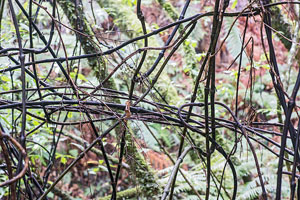 Members of the genus Ripogonum are found in Aotearoa, Australia and New Guinea. All are "tall lianes without tendrils or prickles". Ripogonum scandens is endemic to New Zealand, and has two kinds of stems -- the twining ones growing up from the forest floor, and the thinner shorter ones that branch out from the twining stems when they reach the light. The twining stems are black with scale leaves, 1 to 2 cm in diameter with nodes 10 to 20 cm apart. They snake across the forest floor until the find a tree to climb, but in the process of getting to the canopy may droop and loop, creating an almost impenetrable barrier. This has given them the distinction of being one of "ngā taero o Kupe", one of the obstructions which the explorer Kupe encountered when he visited Aotearoa (see the page on Tatara-a-moa for more information about this). Later explorers had similar experiences. Elsdon Best ((Forest Lore, p.55) quotes from James Cook's account on his second voyage (1768): "In many parts the woods are so over-run with supple-jacks that it is scarcely possible to force one's way amongst them. I have seen several which were fifty or sixty fathoms long." Thickly bunched stems on the forest floor were thought to protect the dwelling places of the Patupaiaruhe. The tangled lianes themselves were characterized in the saying "Ngā taero o Kupe, e, ngā rōrī o te whare o Uenuku" (M&G 2043) -- Uenuku, an irascible High Chief in Hawaiki responsible for many migrations to Aotearoa, found the "obstacles" Kupe had brought back with him just what he needed for securing the door to his house. Similarly in the forest, one might trip over a pirita vine and fall down a ravine to one's doom, or find it invaluable for abseiling down a steep slope. Members of the genus Ripogonum are found in Aotearoa, Australia and New Guinea. All are "tall lianes without tendrils or prickles". Ripogonum scandens is endemic to New Zealand, and has two kinds of stems -- the twining ones growing up from the forest floor, and the thinner shorter ones that branch out from the twining stems when they reach the light. The twining stems are black with scale leaves, 1 to 2 cm in diameter with nodes 10 to 20 cm apart. They snake across the forest floor until the find a tree to climb, but in the process of getting to the canopy may droop and loop, creating an almost impenetrable barrier. This has given them the distinction of being one of "ngā taero o Kupe", one of the obstructions which the explorer Kupe encountered when he visited Aotearoa (see the page on Tatara-a-moa for more information about this). Later explorers had similar experiences. Elsdon Best ((Forest Lore, p.55) quotes from James Cook's account on his second voyage (1768): "In many parts the woods are so over-run with supple-jacks that it is scarcely possible to force one's way amongst them. I have seen several which were fifty or sixty fathoms long." Thickly bunched stems on the forest floor were thought to protect the dwelling places of the Patupaiaruhe. The tangled lianes themselves were characterized in the saying "Ngā taero o Kupe, e, ngā rōrī o te whare o Uenuku" (M&G 2043) -- Uenuku, an irascible High Chief in Hawaiki responsible for many migrations to Aotearoa, found the "obstacles" Kupe had brought back with him just what he needed for securing the door to his house. Similarly in the forest, one might trip over a pirita vine and fall down a ravine to one's doom, or find it invaluable for abseiling down a steep slope.
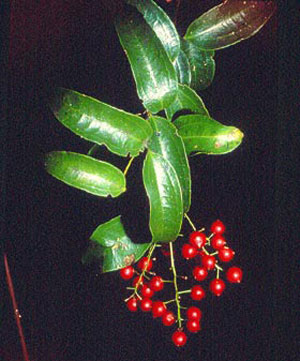 Once they reach the light, the shorter, thinner branches generously covered with sharp-tipped green leaves, 6-16 cm long by 2-6 cm wide, appear. These stems are only 4-5 mm in diameter.
They produce loose strings of very small, green flowers followed by bright red fruit about 1 cm in diameter bearing one or more spotted seeds. (The seeds are edible when cooked, but not particularly tasty.) The fruits persist for a year or more before falling from the bunches. There are varying reports as to their edibility. However Andrew Crowe (Native Edible Plants, p.55) notes that although rather dry and tasteless they have some nutritive value. He also quotes from Jean Boswell's report of the "wonderful beer, clear gold and heady" which her parents made from the roots. Murdock Riley (Herbal, pp. 183-7) and other writers note that it was widely used as a substitute for sarsaparilla in the nineteenth century, and acquired a similar reputation as a kind of cure-all, with external and internal use for a variety of ailments including skin diseases, rheumatic complaints, stomach disorders, and unwanted pregnancies. The stems were used for staunching blood flow and cauterising wounds. A vapour bath from water in which the stems were boiled was used to make childbirth easier. The base of the stem may be swollen into a woody tuber, but this was not regarded as edible. Once they reach the light, the shorter, thinner branches generously covered with sharp-tipped green leaves, 6-16 cm long by 2-6 cm wide, appear. These stems are only 4-5 mm in diameter.
They produce loose strings of very small, green flowers followed by bright red fruit about 1 cm in diameter bearing one or more spotted seeds. (The seeds are edible when cooked, but not particularly tasty.) The fruits persist for a year or more before falling from the bunches. There are varying reports as to their edibility. However Andrew Crowe (Native Edible Plants, p.55) notes that although rather dry and tasteless they have some nutritive value. He also quotes from Jean Boswell's report of the "wonderful beer, clear gold and heady" which her parents made from the roots. Murdock Riley (Herbal, pp. 183-7) and other writers note that it was widely used as a substitute for sarsaparilla in the nineteenth century, and acquired a similar reputation as a kind of cure-all, with external and internal use for a variety of ailments including skin diseases, rheumatic complaints, stomach disorders, and unwanted pregnancies. The stems were used for staunching blood flow and cauterising wounds. A vapour bath from water in which the stems were boiled was used to make childbirth easier. The base of the stem may be swollen into a woody tuber, but this was not regarded as edible.
The plant also had many non-medicinal practical uses. The juice from cut stems was an acceptable drink for a thirsty traveller, and the young shoots are edible and a good substitute for asparagus. The stems have many of the properties of rattan, and were used to make litters and stretchers, fish baskets, crayfish pots, eel and rat traps, for lashing fences and pallisades, and in house construction. Some of these qualities are also present in its Rarotongan namesake, the pirita Jasminium didymum. The split stems provided the material for finely plaited containers, including sieves for sifting hīnau flour, and even musical instruments. The stems were also useful for making walking sticks, and, as Peter de Lange notes in the NZPCN fact sheet for this plant, "they were also (in less politically correct times) the favoured source for canes for use in New Zealand schools!" Many a Māori boy caught speaking Māori at school in the early decades of the 20th century was sent to the bush to cut a pirita cane for his chastisement.
Apart from the saying noted above, there is one more proverb referring to the pirita in the Meade and Grove collection:
He arero kareao ka whati; engari te arero wahine kāore e whati haere tonu ana.
'A tongue of supplejack will crack but not a woman's tongue -- it goes on an on.' This unflattering saying might be amended to apply equally to some men. (M&G, 355)
The one mention in Ngā Mōteatea is in the tangi (lament) for Te Whetukamokamo, a chief who ignored advice and went to try to relieve the seige of Te Whetumatarau, only to be ambushed and killed by his enemies while on his way:
E rere, e oma, kia tae ai koe
He whāwhainga ki a Hinetapora.
Tāweka te pirita te Pā Tirohia.
Escape then, run that you may reach
Speeding to Hinetapora.
Grappling with the supple-jacks at Pā Tirohia.
(NM 21, lines 54-56, Vol. 1, pp. 96-97.)
(Hinetapora was one of Te Whetukamokamo's ancestors. Pā Tirohia "the fortress glimpsed" is a metaphor for an unreachable goal; the pirita will not be penetrated.)
Ngā Pirita kē -- Ētahi tohu anō o te Patunga o Tunanui.
Five species of mistletoe, with species and genera all endemic to Aotearoa, constitute the other relics of the clash between Maui and Tunanui to be grouped with the supplejack as pirita. The family they belong to (Loranthaceae) is found also in Southeast Asia, Australia, Polynesia (except Hawai'i) and Central and South America. Three have spectacular red (or in one case, orange) flowers, the other two leave the colour to their fruit. Unfortunately, most of these species have been viciously attacked by possums and are also endangered by loss of habitat. They are classified as "hemiparasites" (half parasites) because they manufacture a lot of their nutrients themselves through their fully-functioning leaves, while drawing moisture and some nutrients from their hosts.
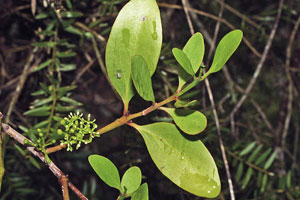 Ileostylus micranthus, also known as Pirinoa, Pirirangi and Pikirangi, is most widespread of the mistletoe pirita. It is found on the North, South and Stewart Islands and also Norfolk Island, and has managed to establish itself on several hundred species of native and exotic trees. It may be found in urban as well as rural and forested environments in coastal and lowland areas, preferring shrubland and secondary growth; it is rarely found at higher altitiudes. Its versatility has kept it from becoming endangered. Ileostylus micranthus, also known as Pirinoa, Pirirangi and Pikirangi, is most widespread of the mistletoe pirita. It is found on the North, South and Stewart Islands and also Norfolk Island, and has managed to establish itself on several hundred species of native and exotic trees. It may be found in urban as well as rural and forested environments in coastal and lowland areas, preferring shrubland and secondary growth; it is rarely found at higher altitiudes. Its versatility has kept it from becoming endangered.
This species is a bushy shrub with thin, yellowish-green leaves variable in shape but rounded at the top and generally attenuated at the base. The leaves are organized in pairs around the stems and 3-8 cm. long. The plant has rhizome-like roots which put out feeding tubes (haustoria) to penetrate the tissue of the host plant. The small green flowers may be single-sexed or hermaphrodite, perhaps depending on the species of tree on which the plant happens to be growing. It produces a single-seeded orange or yellow fruit. Like the other species in this group, the seeds are distributed mainly by birds (especially by tui and bellbirds in the case of the tubular-fowered species). They become glued to the twig or branch on which they land, often with a dose of excrement for good measure. After germination they need to attach themselves to their host without much delay as they do not have the means to look after their needs independently. There is a photograph in the gallery below of a well-resourced newly-germinated Ileostylus seedling starting to attach itself to its host (in this case, a tōtara).
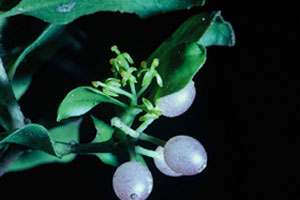 Tupeia antarctica also has tiny yellowish-green flowers. Its alternative names are Tāpia, Kohurangi and Pirinoa. It forms a rounded shrub up to a metre wide, with flehy, bright green leaves of various sizes and shapes (from 1-7 cm long). It has white or greyish bark, and the branchlets are covered with minute hairs. Tupeia antarctica also has tiny yellowish-green flowers. Its alternative names are Tāpia, Kohurangi and Pirinoa. It forms a rounded shrub up to a metre wide, with flehy, bright green leaves of various sizes and shapes (from 1-7 cm long). It has white or greyish bark, and the branchlets are covered with minute hairs.
The scientific name of the shrub commemorates Tupaia, the priest-navigator from Ra'iatea who accompanied James Cook from Tahiti on his first voyage to Aotearoa in 1678-9. Tupaia was born around 1724, and died in December 1770.
The plant has been reported growing on more than 50 hosts, including another mostletoe (Peraxilla tetrapetala). It is found in the North and South Islands, in both forest and scrub, and can sometimes be found hanging like a giant green hive of wild bees from an exposed branch of its host. It attaches itself to its host through an anchoring stem which penetrates the bark.
The flowers occur in bunches, and are followed by fruit of varying colours, sometimes those in the same bunch varying from white to pink to deep purple.
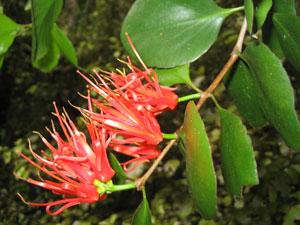 Peraxilla colensoi is a fleshy-leaved shrub up to 3 metres wide growing especially on the outer branches of beech trees, especially Tawhai raunui (Fuscospora fusca) and Tawhai rauriki (F. solandri), although it also has other hosts. Its glossy green leaves are up to 8 cm long, with red edges. Its red tubular flowers about an inch long appear from October to January, followed by small yellow fruit, similar to those of Ileostylus micranthus, and possibly edible: Andrew Crowe (Native Edible Plants, p. 155) comments, in relation to the fruit of these species, "I have eaten the juicy yellow fruit of Ileostylus micranthus raw; it is sweet but with an odd and enduring stickiness typical of mistletoe fruits". The petals of this and the other mistletoes with brightly coloured flowers are shed in great profusion during the flowering season, covering the forest floor in the vicinity of the host tree, and providing an easily read guide to their source. This mistletoe is greatly endangered by the depredations of possums. Peraxilla colensoi is a fleshy-leaved shrub up to 3 metres wide growing especially on the outer branches of beech trees, especially Tawhai raunui (Fuscospora fusca) and Tawhai rauriki (F. solandri), although it also has other hosts. Its glossy green leaves are up to 8 cm long, with red edges. Its red tubular flowers about an inch long appear from October to January, followed by small yellow fruit, similar to those of Ileostylus micranthus, and possibly edible: Andrew Crowe (Native Edible Plants, p. 155) comments, in relation to the fruit of these species, "I have eaten the juicy yellow fruit of Ileostylus micranthus raw; it is sweet but with an odd and enduring stickiness typical of mistletoe fruits". The petals of this and the other mistletoes with brightly coloured flowers are shed in great profusion during the flowering season, covering the forest floor in the vicinity of the host tree, and providing an easily read guide to their source. This mistletoe is greatly endangered by the depredations of possums.
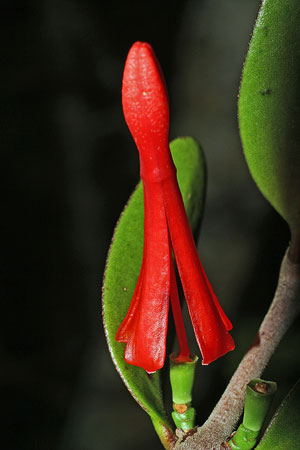 The closely related Peraxilla tetrapetala, also known as Pirirangi, Pikirangi and Roeroe, grows on the inner branches of beech (Tawhai, Fuscospora spp.) trees. It is easily recognized by the blisters on its glossy-green diamond-shaped leaves. The leaves are up to 2.5 cm long, fleshy and arranged in pairs. The plants are shrubs up to 3 m wide and in the October-January flowering season covered with brilliant red tubular flowers, up to 4 cm long. The flowers may open from the top, or, like the rewarewa, start spliitting from the base and unroll upwards. However, unlike the rewarewa, the pirita petals detach from the base and end up on the ground. The flowers appear in the axils of the leaves, singly or up to 4 together, followed by fleshy green fruits. It produces a network of stems which may spread from the branches of the host and travel down the trunk of the host tree, sprouting new leaves and branches at intervals along the stems. The closely related Peraxilla tetrapetala, also known as Pirirangi, Pikirangi and Roeroe, grows on the inner branches of beech (Tawhai, Fuscospora spp.) trees. It is easily recognized by the blisters on its glossy-green diamond-shaped leaves. The leaves are up to 2.5 cm long, fleshy and arranged in pairs. The plants are shrubs up to 3 m wide and in the October-January flowering season covered with brilliant red tubular flowers, up to 4 cm long. The flowers may open from the top, or, like the rewarewa, start spliitting from the base and unroll upwards. However, unlike the rewarewa, the pirita petals detach from the base and end up on the ground. The flowers appear in the axils of the leaves, singly or up to 4 together, followed by fleshy green fruits. It produces a network of stems which may spread from the branches of the host and travel down the trunk of the host tree, sprouting new leaves and branches at intervals along the stems.
This shrub occurs in both main islands, but is more common in the South. Like Peraxilla colensoi it has a variety of hosts, but is particularly fond of Tawhai rauriki (Fuscospora solandri) and its relatives in the beech family (Nothofagaceae).
The last in this list of mistletoe pirita is Alepis flavida, the "yellow mistletoe", another also known as Pirinoa. It is found from Auckland south, but is much more common in the South Island than the North. This forms a sparsely-branched shrub up to a metre high with very thick oval dull-green leaves with reddish margins, 3-5 cm long by about 1 cm wide. Its flowers are tubular, bright orange-yellow 1-2cm long, and occur in clusters of 6-15 flowers. The petals split only about half-way to the base. The flowers are followed by yellow to orange berries, 4-5 mm long. The sucker-forming stems on this species are not as extensive as those on the Peraxilla species, and seldom reach the trunk of the host. Nor do leafy shoots arise from them. There are photographs of this plant and its flowers and fruits in the gallery below.
|

